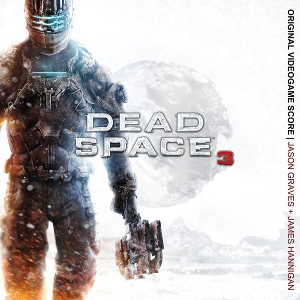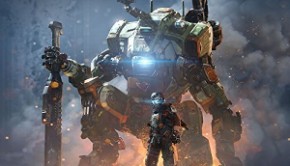Dead Space 3 Original Videogame Score
 |
Album Title: Dead Space 3 Original Videogame Score |
| Record Label: Electronic Arts |
|
| Catalog No.: N/A |
|
| Release Date: February 12, 2013 |
|
| Purchase: Download at iTunes |
Overview
After Dead Space 2 was met with even better reviews and sales figures than its very well-regarded predecessor, you would have thought that releasing another part of the franchise would be relatively smooth sailing – worst case scenario, you deliver more of the same of what made the first two games so successful. However, developer Visceral Games – either by its own choice or on the behest of Electronic Arts – decided to make several tweaks to the Dead Space formula, few of which were met with much love by the established fan base. In the end, Dead Space 3 turned out to be much more closely modelled on the ubiquitous Call of Duty/Gears of War model of first-person shooters than previous Dead Space games, focusing on action rather than horror. Other additions like online co-op, Kinect support and a much-criticised microtransactions scheme didn’t help either. Ultimately, the resulting game was still a decent FPS experience, but both critical acclaim and sales figures lagged behind Dead Space 2.
One of the most outstanding aspects of the first two Dead Space games had been their soundtracks, both receiving very strong reviews and extensive attention even from non-gaming related publications for their willingness to derive inspiration from atonal 20th century classical music. Franchise composer Jason Graves furthered this connotation through the use of a string quartet on Dead Space 2, while broadening the first game’s limited emotional range. After having thus provided the Dead Space franchise with a recognisable trademark sound, Graves teamed up with James Hannigan, whose body of work includes his outstanding contributions to the Harry Potter and Command & Conquer franchises (in fact Graves and Hannigan had collaborated on Command & Conquer 4: Tiberian Twilight). The change in tone and genre that Dead Space 3 as a whole went through would doubtlessly also impact its music – a development that Graves confirmed in an interview when he stated that “Dead Space 3 has a combination of the classic, original Dead Space horror feel with some modern, edgier appointments.” When describing Dead Space 3, Hannigan explained that the wider emotional range of the game’s narrative “provided some scope for a broader emotional palette to exist for music.” According to Hannigan, the cues from Dead Space 3 chosen for the album release would reinforce this impression: “So it’s actually pretty varied, and a balance between atmosphere, exploration, action, cutscene music, boss battles and, of course, moments of abject terror.” That soundtrack album was released in February 2012 and contained a generous 83 minutes of music from the game (but sadly no Phil Collins covers), performed by the Philharmonia Orchestra and the Slovak National Symphony Orchestra.
Body
After all the brouhaha over Dead Space 3‘s move into more action-focused waters, it’s important to clearly state one thing up front: Graves’ Dead Space scores have always combined horror and action elements, merging highly atonal textures (and sometimes melodies) with intense rhythms that matched the brutally dissonant string and brass attacks. Another thing to keep in mind is that Dead Space 2 had already moved away somewhat from the intoxicating aural chaos that was Dead Space, structuring its action cues around more straightforward, but still heavy-hitting rhythms. In other words: there’s no reason to believe that just because Dead Space 3 is more of an action game than a horror title that its music would necessarily suffer or be dumped down. Turns out though that this is exactly what happens on Dead Space 3.
One of the aspects that made Dead Space 2 such an exceptional work was its ability to fuse two diametrically opposed emotions – utmost terror versus despair and fragility – and express them through one coherent musical language, with each side of the equation imbuing the other with gravitas. Hannigan is correct in his assessment that Dead Space 3 features more variety than Dead Space 2, but this time, the different components are either problematic in themselves or badly clash with each other. The fascinating dichotomy at the heart of Dead Space 2 has been replaced with a mix of styles that don’t combine too well, and certainly doesn’t coalesce into something as impressively visceral as Dead Space 2. Dead Space 3 may paint on a bigger canvas, but the end result is a less well-organised and interesting image.
Most of the time, the individual styles of each composer shine through and are easy to tell apart – one reason why during its lengthy running time, the meandering album never quite gels or develops much traction. Not surprisingly, Graves’ contributions are those that most strongly recall the particular sound that the Dead Space franchise has become famous for: the extensive use of fierce, biting dissonances particularly in the strings and brass, creating an orchestral frenzy that is as dense as it is powerful. Graves returns to this sound on his action tracks for Dead Space 3, and while his new battle cues largely feel like regurgitations of his previous franchise work, these compositions are still the best thing about Dead Space 3. While Graves might by now have gone from innovatively exploring cacophonous material to deploying such sounds by formula, it’s still an effective formula – and one that’s still rarely used in the realm of video game scores. “Apoplexia” – or at least its first half – is the prime example of Dead Space 3‘s approach to battle cues, rehashing Dead Space 2‘s action sounds but bringing them back with an impressive amount of ferocious power. Similarly, “The Nexus” is another one-two punch of sonic fury, backed by alternatively whining, simpering and aggressive violin sounds.
Truth be told, Graves has made some slight changes to his approach. The rhythms underpinning many of his action tracks are once more simpler than those heard on earlier Dead Space scores and move the music closer to current action game score conventions. However, the slightly diminished rhythmic complexity is no deal breaker, as Graves usually surrounds his pounding percussion patterns with enough orchestral activity to give the music an extra layer of depth and complexity. What’s more noteworthy is a more obvious concession to action scoring conventions that Graves implements: the existence of heroic, uncomplicated brass elements that pay tribute to the game’s sci-fi FPS aspirations. While one might expect that avantgarde-inspired orchestral spikyness and expressions of militaristic nobility would clash badly, the two elements actually work quite well together on “The Quick and the Dead”, “Spaced Out and Frantic” and the opening of “Vomit Comet”, even though the melodic brass lines occasionally border on the generic. Unfortunately, this impression of deficient originality is reinforced by the fact that the gallant trumpet melody that caps off “The Quick and the Dead” is more or less a straight reprise of Graves’ main theme from Resistance: Burning Skies, with the rest extremely reminiscent of the opening theme for Revenge of the Sith. Given that Burning Skies already suffered from an overuse of this melody, it’s doubly disappointing to see it pop up on Dead Space 3 – not only on “The Quick and the Dead”, but also later on “Knee Deep”. Graves makes amends though with “The Ascent”, which evokes an intriguing sense of wonder through its elegant, chromatic string and brass lines, although the impression only lasts for about a minute.
Another track that sees Graves toying with new ideas is “The Fiery Room”, an effective, unsettling battle cue that is happy to experiment a bit through the introduction of synth elements. While the use of electronic percussion sounds feels somewhat forced, the unstable, spectral synth pads that open the piece are an atmospherically successful addition to the sound palette of the Dead Space universe. Hannigan adopts Graves’ tweaked trademark style for the eight-minute closing track “Moon Crash”, and while the piece doesn’t sustain the sheer energy of Graves’ best blasts of noise, “Moon Crash” manages to stretch its texturally-oriented action material without making the piece monotonous. While not as spectacular as one might hope for, “Moon Crash” still turns out to be a sufficiently big and powerful finale to Dead Space 3, boosted by a commanding performance from the Philharmonia.
Not all is good news though, as a number of factors ensure that Graves’ action material for Dead Space 3‘s ranks below that of Dead Space 2. The biggest culprit is a surprisingly reverb-happy album mix that would be commonplace on a straightforward Remote Control score like Gears of War 3, happy to simply sound big and booming. On a more complex offering like Dead Space 3 though, this approach not only results in a muddy, hollow sound that devours textural detail, but it also blunts the action tracks’ sharp edge. Dead Space 2‘s mix found the perfect balance between forcefulness and a dry sound that vividly captured the music’s abrasive nature. Dead Space 3‘s mix loses this latter asset and robs the soundtrack’s trademark dissonances of some of their impact. Some of the action tracks also simply don’t work too well outside of the game context. For example, “In Tents” mainly relies on its rhythmic elements, but fails to evoke the same blasted barrenness that made the final portions of Dead Space 2‘s commercial album release such a heady experience. Another issue is the fact that while many of Dead Space 3‘s action tracks pack a wallop once they get going, often enough they also feature significant portions of anonymous, vaguely creepy underscore that genre pundits will have heard on dozens of other film and game scores. “Into the Stomach” takes a full three minutes of eerie orchestral mumbling before it finally takes off, and “Apoplexia” and “In Tents” suffer from similar problems. After Dead Space 2 had managed to make even its underscore an integral element of its mesmerising effect, Dead Space 3 unfortunately falls back into the trap of turning its ambient, atmospheric portions into filler material.
Still, the real trouble begins with Hannigan’s material, which makes up about half of Dead Space 3. His contributions, either through his choice or external pressure, stay far closer to the conventions of current action score writing in general, and Remote Control productions in particular – and his pieces sadly remain uninspired and trite, no matter whether they’re trying to communicate danger, bravery or warmth. “Moon Crash” is the only major exception. The opening track “200 Years Ago, On An Icy Planet…” is already indicative of these issues. Running at more than seven minutes, it opens with slow-moving string and brass material that create a subdued mood setter, describing the wideness of outer space in well-familiar, if reasonably effective strokes. The first of several tracks to build over less than imaginative string ostinati, “200 Years Ago, On An Icy Planet” still manages to inject hints of dread into its prosaic strains. Just when the piece is about to turn monotonous, it switches into action-mode through electronic pulses, uninspired ostinati that lack vigour, and brass figures that aim for epic breadth, but fall well short of their ambition.
It’s telling that “200 Years Ago”’s most memorable feature is Dead Space 3‘s main theme, first introduced at 2:46 as an anthemic, simplistic brass melody that is easy enough to enjoy, but feels like a leftover idea from Hans Zimmer’s Inception. The theme returns a number of times on the album, for example on “Broken Down”, “Buckell Down” and most prominently on “Moon Crash”. However, while Hannigan occasionally chooses to split off the theme’s first two notes and perform them separately – they even get to close “Moon Crash” on pensive solo piano – the somewhat underwhelming theme doesn’t undergo any significant development. Thematic coherency is another field in which Dead Space 3 comes up short against its predecessor, although this doesn’t come as a complete surprise. Graves’ idea to link two of Dead Space 2‘s themes to the protagonist’s girlfriend Nicole was clever enough and served the game perfectly well, but he also wrote himself into a corner. Nicole is entirely gone from Dead Space 3‘s narrative, which means that neither of the two themes associated with her can be reprised at any significant length. What’s stranger though is that Dead Space 2‘s marker theme doesn’t return on Dead Space 3, despite the markers’ prominent role in the game – a pity, since the marker theme and its descending four notes gave many of Dead Space 2‘s action tracks a fatalistic determination.
Other contributions by Hannigan after “200 Years Ago” are mostly equally uninspiring. His action writing on tracks like “A Broken Past”, “Lunar Express”, “Rosetta Suite” and “Convergence” is disappointingly banal, usually consisting of thumping, synth-enhanced orchestral rhythms, unoriginal string ostinati, and rising, swelling brass figures that are perfunctory, but clichéd to a fault, making the music often sound like unimaginative action movie trailer music. The similarities between “Lunar Express” and Inception‘s “Mombasa” are especially astonishing. “Cry of the Ancients” almost feels like an unintentional parody of this ostinato-obsessed kind of composition, as the majority of the four minute piece is carried by an incessantly repeated, simple cello figure that gets louder and louder and… that’s it, the piece ends. And no, the tinkling piano line layered on top and the portentous, anaemic background chords from the lower strings and brass don’t count as musical substance. “Convergence” is only slightly more expressive, content to simply hammer out some big brass chords.
This lack of inspiration carries over into Hannigan’s more sensitive compositions. These rely on heavyhearted, somewhat subdued string-driven passages that can only call upon rudimentary and simplistic melodies, which feel like a generic way to address the more emotional aspects of Dead Space 3‘s narrative and characters. “Buckell Down”, “Graffiti Speaks” and “Lunar Express” all try to elicit some emotional response through their basic, superficial melodies, but remain lackadaisical. “Convergence” and “Rosetta Suite” feature more elaborate melodic writing, although the results still aren’t spectacular. After Dead Space 2 did such a sterling job at addressing the emotions at the heart of the game’s story without any sentimentality, it’s immensely disappointing that Dead Space 3 falls so completely flat in this area.
This is not an issue that only befalls Hannigan’s compositions – Graves’ attempts to address the feelings that drive Dead Space 3‘s characters fall behind his work on Dead Space 2, but at least his cues surpass Hannigan’s pieces. “60 Seconds Over Tau Volantis” returns Dead Space 2‘s regretful tones through a conventional three-note piano motif (which is reprised on “Graffiti Speaks”), before Graves nicely mixes in more horror elements that ultimately take over the composition. “Knee Deep” features more mysterious, subdued ‘out there in space’ music similar to what “200 Years Ago” presented (the recording makes the brass calls on this piece sound particularly bad). Despite some reasonably fetching ideas, the piece feels overlong – apart from a closing passage for solo cello and piano that suddenly brings back Dead Space 2‘s fragile, touching introspection which otherwise is sorely lacking on this album, all via a surprising reprise of Isaac’s theme from Dead Space 2. Thankfully, Graves develops this mood and the theme more extensively on “Memories of the Past” on Dead Space 3‘s promotional album release. On this commercial album though, the immense effect that the return of Isaac’s theme yields is only further proof that Dead Space 3 is best when it repeats its predecessors.
Summary
For a franchise that started out as “a little high-brow” and “the antithesis of video game music” – Graves’ own words on Dead Space – Dead Space 3 is a disappointing downgrade. Dead Space 3 feels unorganised and meandering, as it trudges through 83 minutes of material that despite its general sci fi atmosphere never coalesces into a convincing whole, unsure whether it wants to go for action-packed horror or more generic Hollywood-inspired action movie sounds. A good part of the album consists of Graves’ reprising Dead Space 2‘s exciting action material, mixed with some quite standard brass melodies full of military solemnity, and rendered less exciting through the disappointingly muddy and reverberant album mix that results in some serious sound issues.
These dissonant outbursts are badly at odds with Hannigan’s mostly uninspired compositions that alternate between trite, lazy string melodies and equally derivative battle cues full of the usually boring string ostinati, electronic pulses and swelling brass figures. Truth be told though, Graves’ contributions aren’t consistently convincing either, with several pieces suffering from the inclusion of nondescript underscore. A disappointing lack of memorable thematic material only adds to the album’s woes. All in all, Dead Space 3 has some worthwhile bits, but they’re not enough to recommend purchasing this overlong album. Just stick with the first two soundtracks in the franchise, as Dead Space 3 doesn’t add much of value to the Dead Space series.
Do you agree with the review and score? Let us know in the comments below!
2.5
Posted on April 29, 2014 by Simon Elchlepp. Last modified on April 29, 2014.















I agree with the analysis. While I found the score superficially enjoyable, it was disappointing just how derivative some pieces were, unfortunately by both parties. I imagine the change of game and soundtrack direction was largely from orders above, but it seemed to rob the series of much of its individuality. I know both composers are capable of offering something so much better than this.